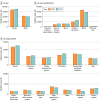Patterns in Cancer Incidence Among People Younger Than 50 Years in the US, 2010 to 2019
- PMID: 37585204
- PMCID: PMC10433086
- DOI: 10.1001/jamanetworkopen.2023.28171
Patterns in Cancer Incidence Among People Younger Than 50 Years in the US, 2010 to 2019
Abstract
Importance: Emerging data suggest that the incidence of early-onset cancers, defined as cancers diagnosed in people younger than 50 years, is increasing, but updated data are limited.
Objective: To characterize the patterns in the incidence of early-onset cancers in the US from 2010 to 2019 and provide granular data on the cancers with the fastest-growing incidence rates.
Design, setting, and participants: This population-based cohort study analyzed data from 17 National Cancer Institute Surveillance, Epidemiology, and End Results registries from January 1, 2010, to December 31, 2019. Age-standardized incidence rates per 100 000 people were extracted for early-onset cancers, with rates age adjusted to the US standard population. A total of 562 145 patients with early-onset cancer between 2010 and 2019 were identified and included. Data were analyzed from October 16, 2022, to May 23, 2023.
Main outcomes and measures: Primary outcomes were incidence rates and descriptive epidemiological data for people younger than 50 years with cancer. The annual percentage change (APC) of the age-standardized incidence rate was estimated using the Joinpoint regression program.
Results: Among 562 145 patients (324 138 [57.7%] aged 40-49 years; 351 120 [62.5%] female) with early-onset cancer, 4565 (0.8%) were American Indian or Alaska Native, 54 876 (9.8%) were Asian or Pacific Islander, 61 048 (10.9%) were Black, 118 099 (21.0%) were Hispanic, 314 610 (56.0%) were White, and 8947 (1.6%) were of unknown race and/or ethnicity. From 2010 to 2019, the age-standardized incidence rate of early-onset cancers increased overall (APC, 0.28%; 95% CI, 0.09%-0.47%; P = .01) and in female individuals (APC, 0.67%; 95% CI, 0.39%-0.94%; P = .001) but decreased in male individuals (APC, -0.37%; 95% CI, -0.51% to -0.22%; P < .001). In contrast, the age-standardized incidence rate of cancers in individuals aged 50 years and older decreased over the study period (APC, -0.87%; 95% CI, -1.06% to -0.67%; P < .001). In 2019, the highest number of incident cases of early-onset cancer were in the breast (n = 12 649). From 2010 to 2019, gastrointestinal cancers had the fastest-growing incidence rates among all early-onset cancer groups (APC, 2.16%; 95% CI, 1.66%-2.67%; P < .001). Among gastrointestinal cancers, those with the fastest-growing incidence rates were in the appendix (APC, 15.61%; 95% CI, 9.21%-22.38%; P < .001), intrahepatic bile duct (APC, 8.12%; 95% CI, 4.94%-11.39%; P < .001), and pancreas (APC, 2.53%; 95% CI, 1.69%-3.38%; P < .001).
Conclusions and relevance: In this cohort study, the incidence rates of early-onset cancer increased from 2010 to 2019. Although breast cancer had the highest number of incident cases, gastrointestinal cancers had the fastest-growing incidence rates among all early-onset cancers. These data may be useful for the development of surveillance strategies and funding priorities.
Conflict of interest statement
Figures
References
-
- National Cancer Institute. Age and cancer risk. National Cancer Institute. Updated March 5, 2021. Accessed June 22, 2023. https://www.cancer.gov/about-cancer/causes-prevention/risk/age
MeSH terms
Grants and funding
LinkOut - more resources
Full Text Sources
Medical



